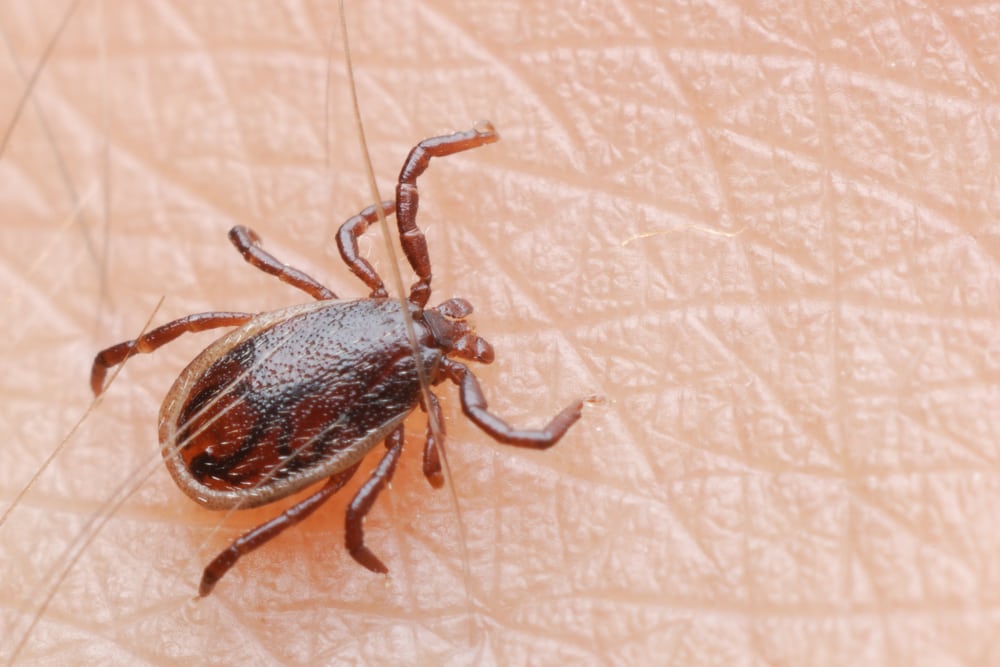Lawn & Garden

Tick populations are rising in Alabama. Ticks thrive in high humidity situations. The recent hot weather and heavy rainfall the state has received is facilitating an increase in these annoying and potentially dangerous ticks. People spending more time at home in their own backyards should expect high tick pressures. For this reason, people are more likely to come into contact with ticks.
Ticks Commonly Encountered in Alabama
Of the two types of ticks, those categorized as hard-body ticks are the most common. Hard-body ticks have a hard shield just behind the mouthparts. Unfed hard-body ticks look like a flat seed. Within the hard-body ticks category, the most common species are the lone star tick, the black-legged tick, and the American dog tick. Additionally, Alabamians may also encounter the brown dog tick and the Gulf Coast tick.
- The lone star tick, also known as the water tick, is the most abundant and annoying. It can be easily identified by its round body and an obvious white dot on the female’s dorsal shield.
- The black-legged tick, also known as a deer tick, is the smallest tick in the United States, with adults growing to approximately the size of a sesame seed. This tick has a u-shaped back and are a reddish-brown color with a solid black dorsal shield and long thin mouthparts.
- The American dog tick, also known as a wood tick, is the largest common tick. They have a u-shaped back, are dark-brown in color with white markings decoration, and have short pointed mouthparts.
What problems do ticks cause for humans?
Ticks bite. Unlike other blood sucking insects—such as bedbugs, fleas, and mosquitoes—ticks attach firmly to their host, feed slowly, and may go unnoticed for several days while feeding. When they feed, ticks grab onto a host, secrete an anesthetic, and painlessly burrow into the skin with their mouth parts. Bites can cause skin irritations or even allergic reactions in sensitive people and pets.
Ticks carry some serious illnesses. Ticks are a growing risk to public health because some of them transfer diseases to human and animals. The diseases include Lyme disease, tularemia, Rocky Mountain spotted fever, ehrlichiosis, babesiosis, Powassan virus disease, Heartland virus, and anaplasmosis—among other illnesses.
Where can humans be exposed to ticks?
Ticks often occur in extremely large numbers and typically have a relatively broad range of hosts. So, they are commonly seen in places where conditions are conducive to the tick-host relationship. Their hosts include wild animals, livestock, and humans. Some specific hosts include chipmunks, ground squirrels, deer, deer mice, birds, reptiles, and feral animals. Ticks acquire their hosts by questing, a process in which they crawl up blades of grass, weeds, and other vegetation and hold out their legs waiting for a host to pass by so they can grab hold.
Ticks do not hang out in the middle of a well-maintained and mowed sunny lawn. The most common outdoor places where ticks are found often are moist/humid areas that have leaf-litter substrate under a foliage canopy such as bushes, shrubs, and tall grass. People should watch for ticks around border areas of lawns, wooded areas, stone walls, and wood piles, particularly in place where the lawn or landscape meets the woodline. Homes that are built next to a forest with a dense wildlife populations have a higher risk of coming into contact with ticks.
Control Methods
The layout and conditions of a property play into which treatment protocol will be necessary. Treatment can be challenging when the property has a lot of shaded areas with dense vegetation close to the ground. To control ticks, people should keep their lawns healthy and trimmed and eliminate any clutter and stored items that would provide shelter for ticks or their hosts.
Rodent control also plays into the treatment protocol. Rodents are a popular host for ticks, so keeping them out of the yard can go a long way in managing tick infestations. Two of the popular rodent control products are tick boxes and tick tubes. Tick boxes give rodents a dose of insecticide when they enter the box to eat bait. Tick tubes contain insecticide-treated nesting material, which the rodents bring into their nests.
Tick dragging is a method by which people use a white sheet to help determine if ticks are present around their property. If they are found, a chemical treatment may be necessary. Tick control programs generally run April through October, depending on weather, with treatment occurring every four to seven weeks.
An application of labeled acaracides should be targeted to the “tick zones.” Labeled liquid concentrates or low-dust granules can be effectively applied with hand-held spreaders quickly with no extended re-entry period. These may be great for areas where pets may frequent and rest. Unless treating for specific species, broadcast lawn treatments are not necessary.
Most ticks are found on vegetation within 12 inches of the ground, so applications of water-based residuals should be directed low into ground-covering vegetation and to the lower branches of shrubs in landscaped areas.
Protection
As with most pests, preventing tick exposure is the key. People can limit their exposure to ticks by wearing repellent, pants, long-sleeve shirts, gloves, and even by tucking their pants into their socks. People should apply a repellent to their body or clothing prior to performing a tick control treatment.

